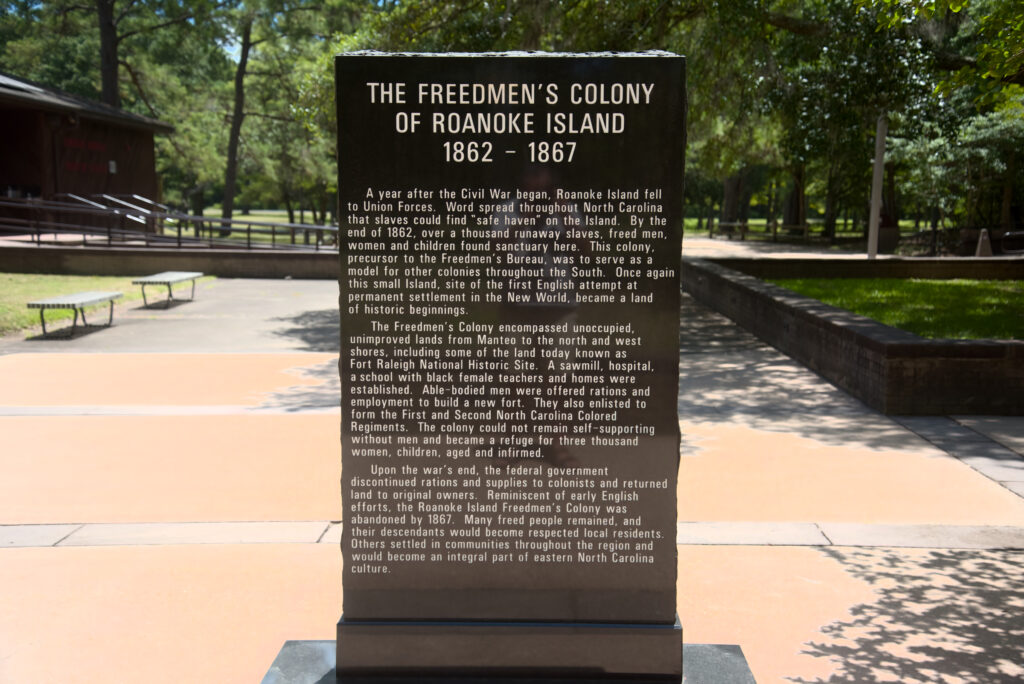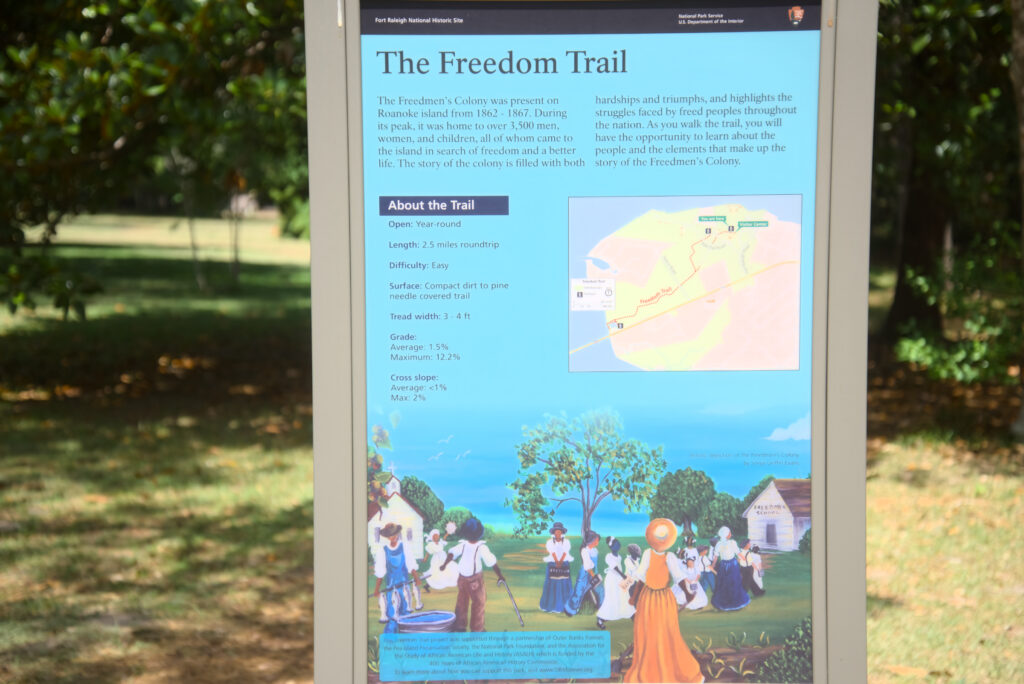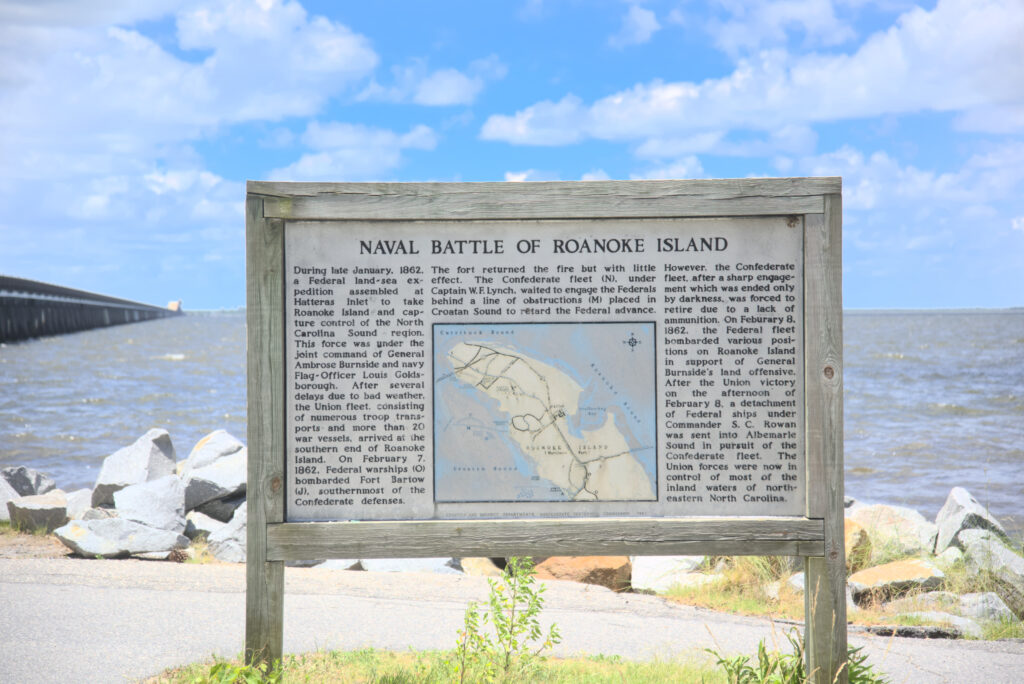Fort Raleigh on the north end of Roanoke Island is the least visited of the National Parks of the Outer Banks. It doesn’t have the romance of the Wright Brothers and their first flight. Nor does it have the beautiful sandy beaches and lighthouses of Cape Hatteras National Seashore. If people are aware of it, it may be because it’s where The Lost Colony is performed in the summer and next to the theater is Elizabethan Gardens.
But Fort Raleigh is much more than 10 acres of formal gardens and the location of a wonderful evening of theater. It is, in fact, a place steeped in history.
Certainly, it is best known as the place where the first English attempt to colonize the New World occurred, and wandering around the grounds, there are exhibits, signs, and archeological evidence making the point.
The Freedmen’s Colony Of Roanoke Island
Not as well known, however, is the story of the Freedman’s Colony, the settlement that sprang up on the north end of Roanoke Island during the Civil War when enslaved people found if they could get to the Union controlled island, they would be free.

Enslaved people fled to the safety of Roanoke Island in droves. An 1864 census of the colony put the population at 3901.
The colony fell apart soon after the war. Some of that was population pressure and the opportunity to go anywhere in the country. Most of it, though, was broken promises from the Federal government, making it almost impossible to remain.
There is almost no evidence that the Freedman’s Colony was ever on Roanoke Island. Other than government records, a smattering of images, and personal recollections from people who lived there, the Freedman’s Colony has left little footprint.
It has not been forgotten, however.
Freedom Trail
The National Park Service has just opened its Freedom Trail, a 2.5 mile out and back trail that is absolutely marvelous in how it chronicles the story of the Freedman’s Colony.
The trail itself is 1.25 miles, but 2.5 for users who reverse their steps.

It is a very easy trail to walk—no hills at all, just a beautiful trek through the shade of a dense maritime forest. It is suitable for anyone aged perhaps 10 or 11 and up. There is no reason someone younger couldn’t walk along the path, but 2.5 miles is a long way for little legs.
The trail starts at the Fort Raleigh visitor’s center. A suggestion, though, is to go to the Elizabethan Gardens parking lot and park on the south side of the lot. The first third of the mile from the Visitors Center is a grassy field with very little shade and not much to recommend. The sign for the trail can be clearly seen from the parking lot.
One of the things that make this such a wonderful experience is how innovative the designers of the trail were in how they conceived telling the story of the people who were there.
Metal silhouette statues stand guard at interpretive signs along the path. The signs themselves tell the story of a life of deprivation and hope. They also tell the story of people who came to Roanoke Island to help the illiterate population learn to live in a free society.

The stories that are told along the Freedom Trail are inspiring and help to create a sense of what the Freedman’s Colony must have been like. The research that had to go into finding some of the specific details of the stories that are told was also remarkable.
This is really something worth adding to the Outer Banks experience.
The trail ends at the foot of the old Manns Harbor Bridge (William B. Umstead). A large sign describing the Naval Battle for Roanoke Island will be there.

For anyone not wanting to retrace their steps, an alternate way back to the beginning of the trail is to walk along the Roanoke Island multi-use path back to the turn for Fort Raleigh. It will be the second road on the left.
A Much Easier Trail
There is another trail through the maritime forest at Fort Raleigh, which is much shorter—only half a mile— and just as easy as the Freedom Trail.
Named after Thomas Harriot, the scientist who accompanied the second English exploration of Roanoke Island, the trail begins a little past the excavation of the earthen berms.

This is a loop trail perfect for little legs. There is a very short spur trail that leads to Croatan Sound and the backstage of the Waterside Theater, where The Lost Colony is performed. The full-sized prop of the ship used in the play is right there where the trail comes out.
One suggestion: From mid—May through September, it’s probably a good idea to use insect repellant when walking the trails.
